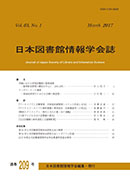Volume 63, Issue 1
Displaying 1-11 of 11 articles from this issue
- |<
- <
- 1
- >
- >|
Article
-
2017 Volume 63 Issue 1 Pages 1-19
Published: 2017
Released on J-STAGE: March 22, 2017
Download PDF (977K) -
2017 Volume 63 Issue 1 Pages 20-36
Published: 2017
Released on J-STAGE: March 22, 2017
Download PDF (15301K)
Book Review
-
2017 Volume 63 Issue 1 Pages 37-38
Published: 2017
Released on J-STAGE: March 22, 2017
Download PDF (568K) -
2017 Volume 63 Issue 1 Pages 39-40
Published: 2017
Released on J-STAGE: March 22, 2017
Download PDF (603K) -
2017 Volume 63 Issue 1 Pages 41-42
Published: 2017
Released on J-STAGE: March 22, 2017
Download PDF (610K) -
2017 Volume 63 Issue 1 Pages 43-44
Published: 2017
Released on J-STAGE: March 22, 2017
Download PDF (603K) -
2017 Volume 63 Issue 1 Pages 45-46
Published: 2017
Released on J-STAGE: March 22, 2017
Download PDF (562K)
-
2017 Volume 63 Issue 1 Pages 47-53
Published: 2017
Released on J-STAGE: March 22, 2017
Download PDF (748K) -
2017 Volume 63 Issue 1 Pages 54-65
Published: 2017
Released on J-STAGE: March 22, 2017
Download PDF (778K) -
2017 Volume 63 Issue 1 Pages 66-70
Published: 2017
Released on J-STAGE: March 22, 2017
Download PDF (664K)
Erratum
-
Article type: Erratum
2017 Volume 63 Issue 1 Pages e1-
Published: 2017
Released on J-STAGE: March 22, 2017
Download PDF (532K)
- |<
- <
- 1
- >
- >|
